Description
Morgan Dollar History
The Morgan dollar was a United States dollar coin minted from 1878 to 1904, and then again in 1921. It was the first standard silver dollar minted since production of the previous design, the Seated Liberty dollar, ceased due to the passage of the Coinage Act of 1873, which also ended the free coining of silver. The coin is named for its designer, United States Mint Assistant Engraver George T. Morgan. The obverse depicts a profile portrait representing Liberty, while the reverse depicts an eagle with wings outstretched.
The dollar was authorized by the Bland–Allison Act. Following the passage of the 1873 act, mining interests lobbied to restore free silver, which would require the Mint to accept all silver presented to it and return it, struck into coin. Instead, the Bland–Allison Act was passed, which required the Treasury to purchase between two and four million dollars’ worth of silver at market value to be coined into dollars each month. In 1890, the Bland–Allison Act was repealed by the Sherman Silver Purchase Act, which required the Treasury to purchase 4,500,000 troy ounces (140,000 kg) of silver each month, but only required further silver dollar production for one year. This act, in turn, was repealed in 1893.
In 1898, Congress approved a bill that required all remaining bullion purchased under the Sherman Silver Purchase Act to be coined into silver dollars. When those silver reserves were depleted in 1904, the Mint ceased to strike the Morgan dollar. The Pittman Act, passed in 1918, authorized the melting and recoining of millions of silver dollars. Pursuant to the act, Morgan dollars resumed mintage for one year in 1921. The design was replaced by the Peace dollar later the same year.
In the early 1960s, a large quantity of uncirculated Morgan dollars was found to be available from Treasury vaults, including issues once thought rare. Individuals began purchasing large quantities of the pieces at face value, and eventually the Treasury ceased exchanging silver certificates for silver coin. Beginning in the 1970s, the Treasury conducted a sale of silver dollars minted at the Carson City Mint through the General Services Administration. In 2006, Morgan’s reverse design was used on a silver dollar issued to commemorate the old San Francisco Mint building In 1873, Congress enacted the Fourth Coinage Act, which effectively ended the bimetallic standard in the United States by demonetizing silver bullion. Prior to enactment of the Coinage Act, silver could be brought to the mints and coined into legal tender for a small fee. With such a system in place, bullion producers could have silver coined into dollars when the intrinsic value of a silver dollar was lower than the face value, thus making a profit, flooding the money supply and causing inflation. The act ended production of the standard silver dollar (then the Seated Liberty dollar, as designed by Christian Gobrecht) and provided for mintage of a silver trade dollar, which was intended to compete with Mexican dollars for use in the Orient. Under the act, bullion producers were allowed to bring bullion to the mints in order to be cast into bars or coined into the newly authorized trade dollars for a small fee. Trade dollars initially held legal tender status, but it was revoked in 1876 to prevent bullion producers from making a profit by coining silver into trade dollars when the value of the metal was low. The restrictions on free coinage laid out in the Coinage Act initially met little resistance from mining interests until the price of silver declined rapidly due to increased mining in the Western United States. Protests also came from bankers, manufacturers and farmers, who felt an increased money supply would have a positive impact. Groups were formed that demanded the free coinage of silver (or “Free Silver”) in order to inflate the dollar following the Panic of 1873.
Beginning in 1876, several bills were introduced in the House of Representatives in an effort to resume the free coinage of silver. One such bill introduced into the House by Democratic Representative Richard P. Bland of Missouri was passed in the fall of 1876. Republican senator William B. Allison of Iowa added important amendments to the bill in the Senate. The House bill allowed Free Silver; one of Allison’s amendments struck that provision. This same amendment allowed for the issuance of silver certificates for the first time in United States history. The bill was vetoed by President Rutherford B. Hayes. The president’s veto was overridden on February 28, 1878. What came to be known as the Bland–Allison Act required that the Treasury purchase between two and four million dollars’ worth of silver per month, to be coined into silver dollars at the former gold/silver value ratio of 16:1, meaning that one ounce of gold would be valued the same as sixteen ounces of silver
In 1876, Director of the Mint Henry Richard Linderman began efforts to redesign the nation’s silver coins. Linderman contacted C.W. Fremantle, Deputy Master of the Royal Mint in London, requesting him to “find a first class die-sinker who would be willing to take the position of Assistant Engraver at the Mint at Philadelphia.” In response to Linderman’s request, Fremantle wrote “My inquiries as to an Assistant Engraver lead me very strongly to recommend for the post Mr. George Morgan, age 30, who has made himself a considerable name, but for whom there is not much opening at present in this country.”[8] An agreement was reached between Linderman and Morgan for the engraver to work at the Philadelphia Mint under Chief Engraver William Barber on a six-month trial basis
Morgan arrived in Philadelphia on October 9, 1876. His earliest pattern coins designed during his tenure at the Philadelphia Mint were intended for the half dollar. In 1876, Morgan enrolled as a student at the Pennsylvania Academy of the Fine Arts to prepare to create a new Liberty head design. Morgan also obtained studies from nature of the bald eagle for preparation of the reverse design. For the representation of Liberty, Morgan sought to depict an American woman rather than the usual Greek–style figures.[10] Morgan’s friend, artist Thomas Eakins, suggested he use Anna Willess Williams of Philadelphia as a model. In total, Morgan had five sittings with Williams; he declared her profile to be the most perfect he had seen.
On October 18, 1877, Linderman requested Superintendent of the Philadelphia Mint James Pollock to “instruct Mr. Morgan to prepare without delay, dies for a silver dollar, the designs, inscriptions, and arrangement thereof to be the same as the enclosed impression for the Half Dollar and numbered ‘2’ substituting the words ‘one dollar’ in place of ‘half dollar'”. Linderman also ordered Pollock to “instruct Mr. Barber to prepare a reverse die for a dollar with a representation of an eagle as well as the inscriptions required by law. He will select whichever of his Heads of Liberty he prefers for the obverse of the same.” Linderman evidently preferred the designs of Morgan over those of the Chief Engraver; he wrote Pollock on February 21, 1878, “I have now to state for your information, that it is my intention, in the event of the silver bill now pending in Congress, becoming law, to request the approval by the Secretary of the Treasury, of the dies prepared by Mr. Morgan
Production of the coins did not commence until March 11, more than a week after the passage of the Bland–Allison Act. The first acceptable strike, after adjustments to the press, was coined at 3:17 p.m. at the Philadelphia Mint. This piece was given to President Hayes; the second and third were given to Secretary of the Treasury John Sherman and to Mint Director Henry Linderman.
Linderman desired to involve the western mints of San Francisco and Carson City in production in order to help reach the monthly quota necessary under the Bland–Allison Act. Pressure was so great at the Philadelphia Mint that it halted production of all other coins and began operating overtime. Use of the western mints was delayed, however, as all dies were prepared at the Philadelphia Mint, and it was believed that the Western mints did not have the proper equipment to prepare the dies for use. During the second week of production, Linderman pointed out what he called a “slight imperfection” in the dies for the dollar. The reason for the changes was to reduce the relief of the designs and to change the number of tail feathers on the eagle from eight to seven; this was done because all prior United States coinage depicted the bald eagle as having an odd number of tail feathers. The high relief had caused the dies to have a shorter life. Dies were eventually sent to the Western mints, arriving in both San Francisco and Carson City on April 16, 1878. The New Orleans Mint began striking the new silver dollars in 1879. Throughout the series numerous small die varieties occurred. These have been cataloged by Leroy Van Allen and George Mallis into VAM Numbers for each year, and examples of each are in demand by advanced collectors.
The Denver Mint, established in 1906, struck the coins for only one year, in 1921. The mint marks appearing on the coins are none, representing Philadelphia, “CC” for Carson City, “S” for San Francisco, “O” for New Orleans and “D” for Denver. In order to conform to the Coinage Act of 1837, the Morgan dollar contained ninety percent silver and ten percent copper, measured 38.1 millimetres (1.50 in) in diameter and weighed 412.5 grains (26.73 g).

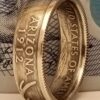
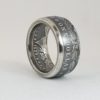




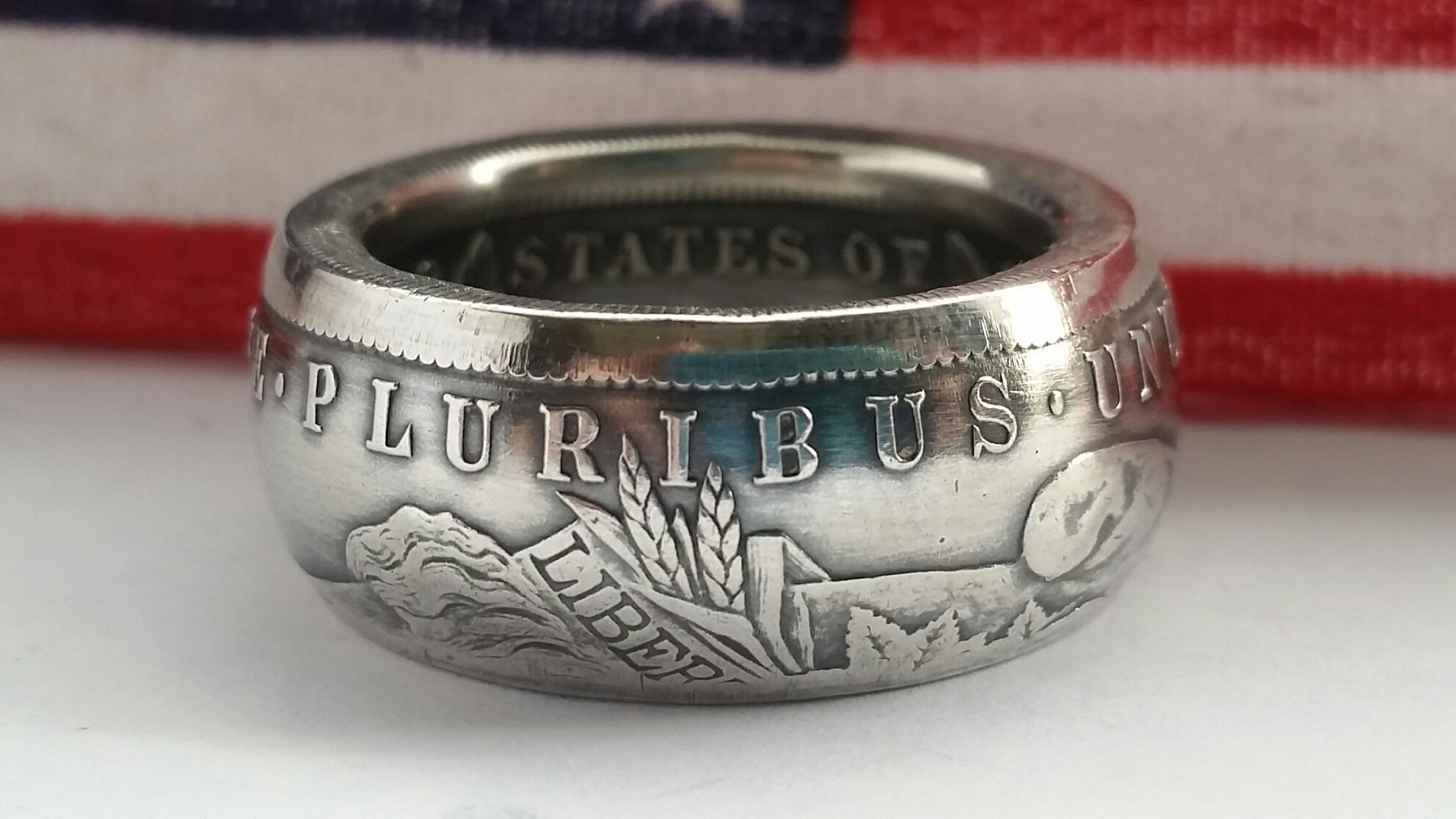
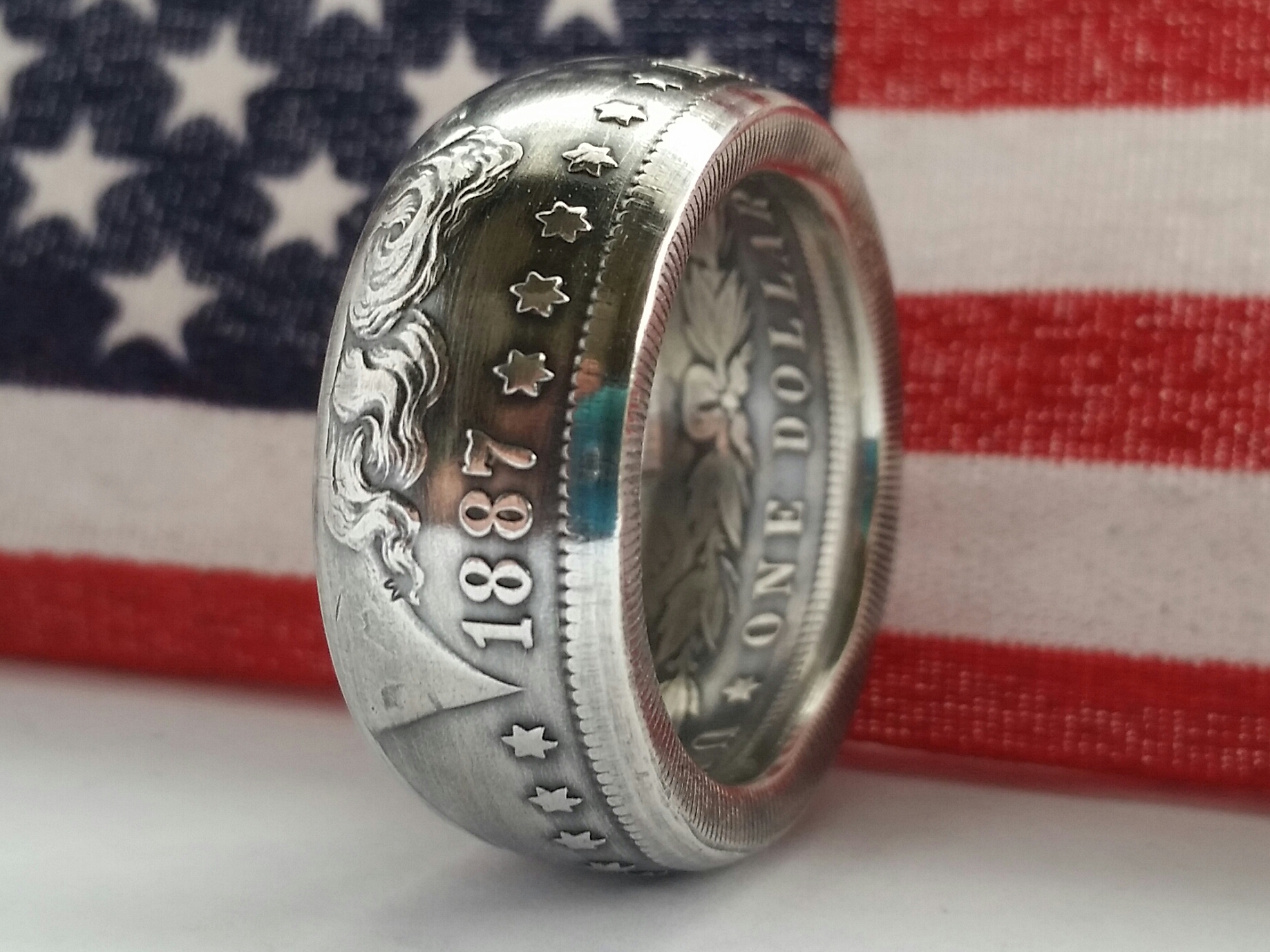
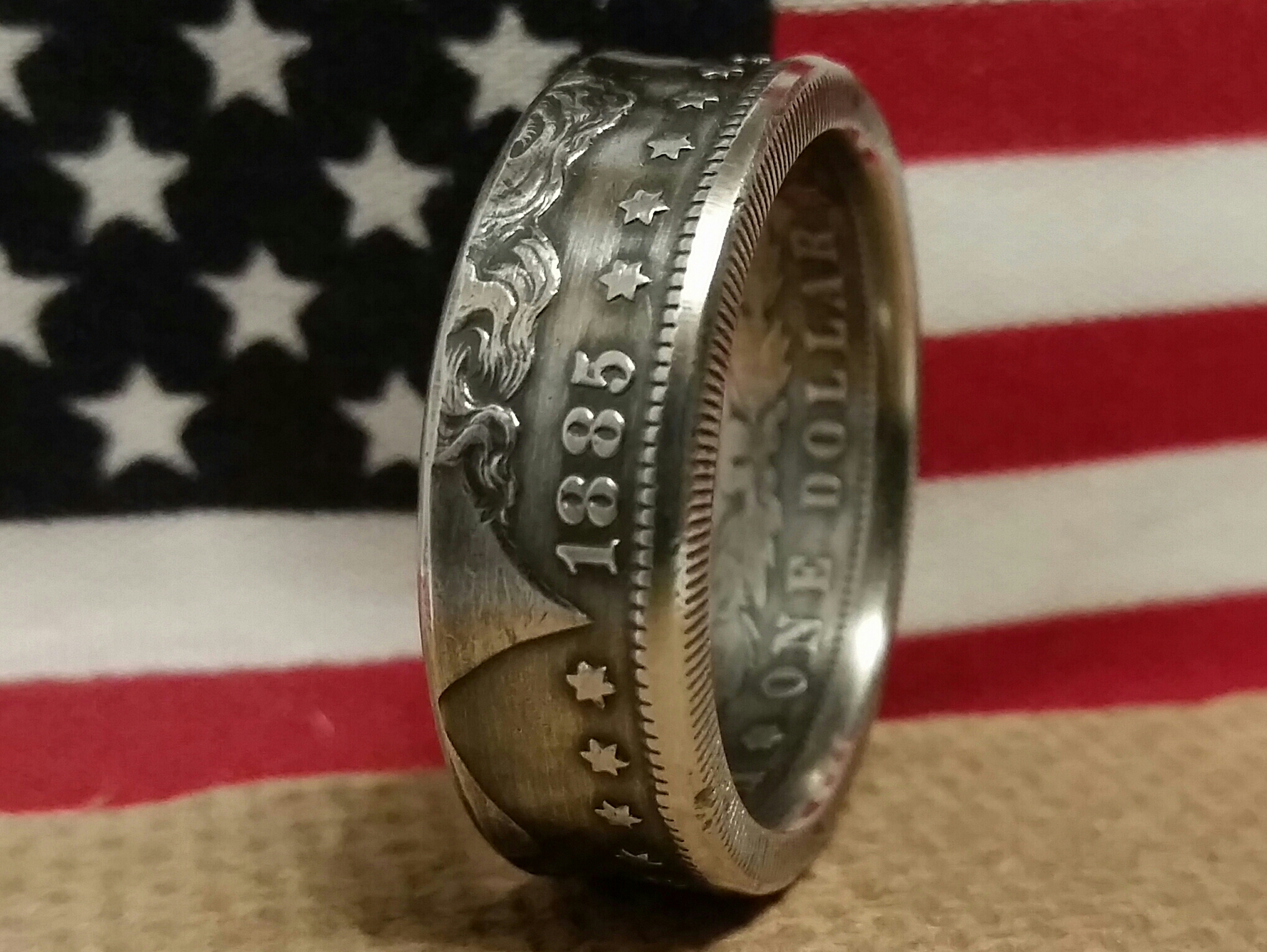























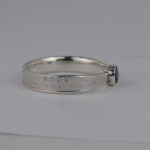




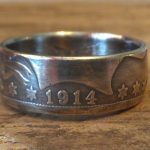

Phillip (verified owner) –
I knew i would regret not getting both the tails out and heads out rings. I love my ring . Fit finish and quality is perfect. God bless
Bill (verified owner) –
Just received my Morgan 1888 and it is AMAZING! Thank you Skyler for making th effort to get the exact date that I wanted!
rsmoena (verified owner) –
Thank you Skyler for such an amazing ring and going the extra mile to get the year I wanted 1885….I wear it every day!
Bill (verified owner) –
Just received both my morgan rings, 1878 and 1921 and thank you for letting me pick my years. I don’t usually write reviews, but this is one I’d be amiss if i let it pass. Skyler the rings are absolutely perfect and beautiful. I’ll contact you soon because everyone in my family will be wearing one of your rings. I can’t thank you enough! Blessings on you.
denali96 (verified owner) –
Just received my Heads-Side-Out Morgan. I love it! While I agree the Tails-Side-Out is probably the Best choice if you can only get one – but I went with both! Size 10 for the Index Finger (In God We Trust) and Size 9 for the ring finger (E pluribus unom). Beautifully crafted and fun to wear!
ptiff1234 –
Recieved Mine today just as i Was leaving for Work.My wife And i got each other new wedding bands for our anniversary,i got tails side out,First Ring ive liked since i lost my original Band.has a solid feel,ill be buying others.
Rick Dominguez (verified owner) –
I just received my ring and it’s more than I was expecting it’s bigger and nicer than I thought that it would be nice job and I’ll be ordering more rings and I’m saving up for a gold coin ring I know that it will be nicer than my Morgan silver dollar ring great job
y2k2000dotcom –
The two silver rings I ordered exceeded my expectations. The silver Morgan looks exactly as pictured. Thank you.